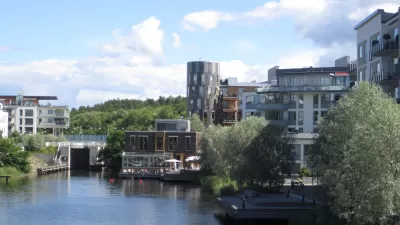The historic Fort Mason, along with several other development projects, has helped alter the landscape of the city’s northern waterfront, according to Jim Chappell, former head of the San Francisco Planning and Urban Research Association.
While development in the aftermath of the Loma Prieta earthquake and the decimation of the double-decker Embarcadero Freeway have helped to transform San Francisco’s northern waterfront, work on the historic Fort Mason Center project has been slow going.
Jim Chappell, an architect and planner who led the San Francisco Planning and Urban Research Association (SPUR) for 15 years, describes several developments that are reshaping the area and discusses how the Fort Mason project is finally gaining ground.
“For years, it has all fallen apart when one hits Van Ness. But a brilliant new plan for the non-profit Fort Mason Center is about to change all that.”
The National Park Service owns the Fort Mason property. New development on the site includes the opening this week of the reconceived Pier 2, a 35,000-square foot, $21 million project, Chappell writes. This follows a $13 million pier substructure upgrade the park service completed.
The changes were ushered in the 2012 International Design Competition in which 20 firms were invited to submit entries for revamping Fort Mason, according to Chappell.
For years, the nonprofit foundation that runs the historic Fort Mason helped to preserve some of the cultural institutions.
“But like every other real estate venture, the world has changed for Fort Mason since September 15, 2008. The National Park Service is squeezed for resources; the non-profit tenants have always been; and Fort Mason is searching for new ways to meet its mission of supporting arts and culture in San Francisco. Thus the design competition. The competition brief called for visions to “inject cohesion, focus, and renewed energy into the campus” and “enhance Fort Mason Center’s profile as an arts and cultural destination.”
Visit Urbdezine to read more.
FULL STORY: Completing San Francisco’s Northern Waterfront

Study: Maui’s Plan to Convert Vacation Rentals to Long-Term Housing Could Cause Nearly $1 Billion Economic Loss
The plan would reduce visitor accommodation by 25,% resulting in 1,900 jobs lost.

North Texas Transit Leaders Tout Benefits of TOD for Growing Region
At a summit focused on transit-oriented development, policymakers discussed how North Texas’ expanded light rail system can serve as a tool for economic growth.

Why Should We Subsidize Public Transportation?
Many public transit agencies face financial stress due to rising costs, declining fare revenue, and declining subsidies. Transit advocates must provide a strong business case for increasing public transit funding.

How to Make US Trains Faster
Changes to boarding platforms and a switch to electric trains could improve U.S. passenger rail service without the added cost of high-speed rail.

Columbia’s Revitalized ‘Loop’ Is a Hub for Local Entrepreneurs
A focus on small businesses is helping a commercial corridor in Columbia, Missouri thrive.

Invasive Insect Threatens Minnesota’s Ash Forests
The Emerald Ash Borer is a rapidly spreading invasive pest threatening Minnesota’s ash trees, and homeowners are encouraged to plant diverse replacement species, avoid moving ash firewood, and monitor for signs of infestation.
Urban Design for Planners 1: Software Tools
This six-course series explores essential urban design concepts using open source software and equips planners with the tools they need to participate fully in the urban design process.
Planning for Universal Design
Learn the tools for implementing Universal Design in planning regulations.
Ascent Environmental
Borough of Carlisle
Institute for Housing and Urban Development Studies (IHS)
City of Grandview
Harvard GSD Executive Education
Toledo-Lucas County Plan Commissions
Salt Lake City
NYU Wagner Graduate School of Public Service




























